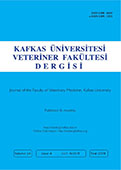
This journal is licensed under a Creative Commons Attribution-NonCommercial 4.0 International License
Kafkas Üniversitesi Veteriner Fakültesi Dergisi
2018 , Vol 24 , Issue 4
[ 68Ga]Ga-AntiCAD1: Radiosynthesis and First Imaging Study on Rats
1Yildiz Technical University, Chemical and Metallurgical Engineering Faculty, Bioengineering Department, TR-34210 - Istanbul. TURKEY2VKF American Hospital, Department of Nuclear Medicine and Molecular Imaging, TR-34365 Istanbul - TURKEY
3Koc University, School of Medicine, Department of Nuclear Medicine and Molecular Imaging, TR-34010 Istanbul - TURKEY DOI : 10.9775/kvfd.2018.19487 Cadherins are cell adhesion and cell signaling molecules that provide the molecular link between each adjacent cells and have critical importance for the initiation and continuation of adhesion mechanism. N-cadherin expression provides a correlation between upregulation of N-cadherin and inflammation of the lesions. In this paper, we concentrated on the radiolabeling and evaluation of [68Ga]Ga-AntiCAD1 agent as a potential candidate for in vivo PET/CT imaging of adhesions. The synthetic N-Ac-CHAVC-NH2 cyclic peptide sequence designed as (ADH-1)c containing the selective binding His-Ala-Val (HAV) motif based on the chimeric antigen receptor sequence acts as the N-cadherin antagonist. In our previous study, AntiCAD1 conjugate has been studied in detail which is in the process of publication. In this study, the conjugate was radiolabelled with the [68Ga]Ga radionuclide eluted from the 68Ge/68Ga generator (IDB Holland). Radiochemical purity of [ 68Ga]Ga-AntiCAD1 agent was analysed with TLC methods. The "shake-flask" method was applied to determine lipophilicity of the agent by calculating the P distribution coefficient (logP=-2.69±0.54). The biodistribution of the agent was investigated using PET/CT on Wistar Albino rats. Significant uptake was found in liver, kidneys, spleen, salivary gland and targeted region with SUVmax-mean of 1.36, 1.96, 1.38, 1.16 and 2.14 respectively. The Pearson Factorial method is used to test the relationship between the targeted region and other body tissues, to measure the degree of this relationship (R=0.73). Radiolabelled agent was demonstrated to react specifically with N-cadherin in targeting of rat tissues. Keywords : AntiCAD1 agent, Peptide Radiopharmaceuticals, PET/CT Imaging, N-Cadherin expression










